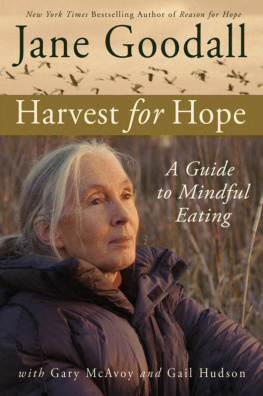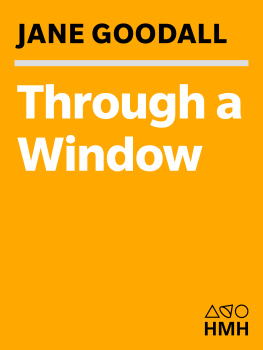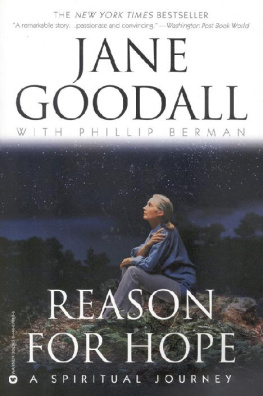Jane Goodall - Harvest for Hope: A Guide to Mindful Eating
Here you can read online Jane Goodall - Harvest for Hope: A Guide to Mindful Eating full text of the book (entire story) in english for free. Download pdf and epub, get meaning, cover and reviews about this ebook. year: 2005, publisher: Hachette Book Group, genre: Home and family. Description of the work, (preface) as well as reviews are available. Best literature library LitArk.com created for fans of good reading and offers a wide selection of genres:
Romance novel
Science fiction
Adventure
Detective
Science
History
Home and family
Prose
Art
Politics
Computer
Non-fiction
Religion
Business
Children
Humor
Choose a favorite category and find really read worthwhile books. Enjoy immersion in the world of imagination, feel the emotions of the characters or learn something new for yourself, make an fascinating discovery.
- Book:Harvest for Hope: A Guide to Mindful Eating
- Author:
- Publisher:Hachette Book Group
- Genre:
- Year:2005
- Rating:4 / 5
- Favourites:Add to favourites
- Your mark:
- 80
- 1
- 2
- 3
- 4
- 5
Harvest for Hope: A Guide to Mindful Eating: summary, description and annotation
We offer to read an annotation, description, summary or preface (depends on what the author of the book "Harvest for Hope: A Guide to Mindful Eating" wrote himself). If you haven't found the necessary information about the book — write in the comments, we will try to find it.
Harvest for Hope: A Guide to Mindful Eating — read online for free the complete book (whole text) full work
Below is the text of the book, divided by pages. System saving the place of the last page read, allows you to conveniently read the book "Harvest for Hope: A Guide to Mindful Eating" online for free, without having to search again every time where you left off. Put a bookmark, and you can go to the page where you finished reading at any time.
Font size:
Interval:
Bookmark:

Copyright 2005 by Jane Goodall with Gary McAvoy and Gail Hudson All rights reserved.
The table on page 156 is by Rich Pirog, 2002. How Far Do Your Fruits and Vegetables Travel? Leopold Center for Sustainable Agriculture, Iowa State University. From the In-a-Nutshell series How Far Does Your Food Travel? from the Center for Urban Education about Sustainable Agriculture.
The Farm Sanctuary Adopt-a-Turkey Project information on page 113 courtesy of Farm Sanctuary.com
Warner Books
Hachette Book Group, USA
237 Park Avenue, New York, NY 10017
Visit our Web site at www.hachettebookgroupusa.com.
First eBook Edition: November 2005
ISBN: 978-0-7595-1486-7
This book is dedicated to the thousands of small farmers who are valiantly struggling to survive, especially those who have embraced organic practices; to those who stand up to speak out against the bullying tactics of agribusiness; to the men and women who work tirelessly to reintroduce the citizens of the fast food nations to real, wholesome food.
And to the billions of farm animals held in torment around the world.
This book would never have been started but for Gary McAvoy, who convinced me that such a book was needed, and that my voice should deliver the message. It has involved endless research, talking with people, and, most important, thinking through the issues. And none of this would have been possible without the help and generosity of many people along the way.
I worked to finish the text of this book during my May to June 2005 U.S. tour, and I could not have coped without the help of Mary Lewis and Rob Sassor. Mary must have sent off thousands of e-mails to distant places around the globe, often working late into the night. Rob was traveling with Mary and me, and he drafted much material, followed up leads, and worked tirelessly to help us meet the deadline.
In writing the chapter dealing with genetically modified food, in particular, I sought advice from many people: Tom Griffith-Jones; Lord Peter Melchett; and Dr. Stanley Ewan, who, working with Dr. Arpad Pusztai, provided valuable insights regarding the work with rats and genetically modified potatoes and tomatoes.
Howard Buffett helped me to understand a variety of issues regarding the growing of corn, and Robert Eden of Comte Cathare vineyards in France told me a lot about his organic vineyards. I am thankful to Nancy and Jerome Kohlberg of Cabbage Hill Farm, who shared their insights on organic farming. And I am grateful to Shadowhawk and his son Washo for sharing their beautiful story with us.
Katie Faulkner helped us to get a number of photographs from Compassion in World Farming, and Margaret Foster sent some from Advocates for Animals. Lesley Day, of Chimps, Inc., provided photos and valuable research. Gloria Grow of Fauna Foundation also helped with photos. In particular, my good friend Tom Mangelsen not only provided many photos but spent considerable time obtaining images for this book. My deepest gratitude to you, Tom.
Many people worked incredibly hard, sometimes into the night, to select our photographs, get them in the right format, and get permissions. My heartfelt thanks to this team: Jeff Orlowski, Rob Sassor, Mary Lewis, Brent Wenner, and most particularly, Michael Aisner and Nona Gandelman, who worked all through Independence Day. I also want to thank Emily Griffin at Warner Books, who received our images from all over the world.
Judy Waters, my sister, kept my body and soul together with her great (organic) cooking during the time I was able to write at our home, the Birches, in the U.K.
I am grateful for the attention and many helpful suggestions given to the manuscript by Natalie Kaire of Time Warner. Without Gail Hudson, who joined us half way through this project, Harvest for Hope would not have been ready for publication. Not only does Gail work extraordinarily hard, but she has a passion for the subject and she writes like a dream. She has been a delight to work with, I am thrilled she came on boardand I have made a new friend.
I am eternally grateful to my wonderful friends Jonathan Lazear, our agent, and Jamie Raab, our editor at Warner Books. I cannot imagine many agents or publishers who would have shown such patience and understanding. We thank both of you so, so much.
Jane Goodall, July 2005
Many thanks to each of the friends and colleagues who shared their ideas, inspiration, and help in shaping this book: Renee Bell, Marlene Blessing, John Burgess, Hans Cole, Joy Delf, Mike and Virginia Duppenthaler, Charles and Rose Ann Finkel, Deborah Koons Garcia, Kathy Humphrey, Robin Kobaly, Tara Kolden, Laura Krebsbach, Frankie Lapp, Deborah Madison, Dave Miller, John Mullen, Mary Ann Naples, Boanna Owens, Brenda Peterson, Clarice Swanson, Doug Thompson, Peter Vartabedian, Craig Winters, and Sue Conley and Peggy Smith at Cowgirl Creamery.
Gary McAvoy and Gail Hudson, July 2005
Why, people ask me, are you writing a book about food? I suppose it seems strange to those who do not know me: I am, after all, the Chimpanzee Lady; in Asia I am often called the Chimpanzee Mother. So why would I be interested in eating? Let me explain.
I spent hours and hours, from 1960 onward, watching chimpanzees feeding. I collected specimens of what they were eating. I noted the behavior associated with eating keep everyone away, if you possibly can, unless there is more than enough for everyone. Which means, if you are the boss, you can keep everyone away from food that you really enjoy. I found, over time, that dominant females had a more successful reproductive careerthey started having babies earlier, and they had more of them. So it was clear that high dominance rank helped you get more food, and the best food, and that this would help your offspring, especially your daughters. Then they, like their mothers, would become high-ranking and successful. Food, therefore, was important. And, I found, they would fight over food, especially a favored food in short supply.
When I was not in the forest, where I most loved to be, I spent a lot of time people watching. Just for fun. In the late 1960s, when I began giving lectures about chimpanzees, I was really terrified of public speaking (though no one knew it). I often found myself at dinner parties that took place before I spoke. With my stomach in knots, there was no way I could eat. So I used to watch people. It helped calm my nervousness because, underneath the supposed civilized veneer of twentieth-century Homo sapiens I could so easily see the same kind of behavior I had, for so long, watched in my chimpanzees.
Then, in 1986, I attended a Chicago Academy of Sciences conference called Understanding Chimpanzees that changed my life. All those studying chimpanzee behavior in Africa, and many studying them in zoos, came together, under one roof, for a four-day conference. It became clear that these amazing apes were in trouble. Their habitat was vanishing. They were treated cruelly in many captive situations. And they were being eaten. They were being hunted and sold for food to make money. I found that this had become a serious problemnot only for chimpanzees, but for all forest animalsbecause, in addition to subsistence hunters who have from time immemorial lived off the bounty of the forest, animals were now being hunted commercially. This was made possible by the new roads built by foreign timber companies, which provide access to previously inaccessible forests. Hunters rode the trucks, camped at the end of the roads, shot everything edible, from elephants to bats, smoked it, and sold it in town, where the urban elite paid more for this bushmeat than for chicken or goat meat.
Font size:
Interval:
Bookmark:
Similar books «Harvest for Hope: A Guide to Mindful Eating»
Look at similar books to Harvest for Hope: A Guide to Mindful Eating. We have selected literature similar in name and meaning in the hope of providing readers with more options to find new, interesting, not yet read works.
Discussion, reviews of the book Harvest for Hope: A Guide to Mindful Eating and just readers' own opinions. Leave your comments, write what you think about the work, its meaning or the main characters. Specify what exactly you liked and what you didn't like, and why you think so.






